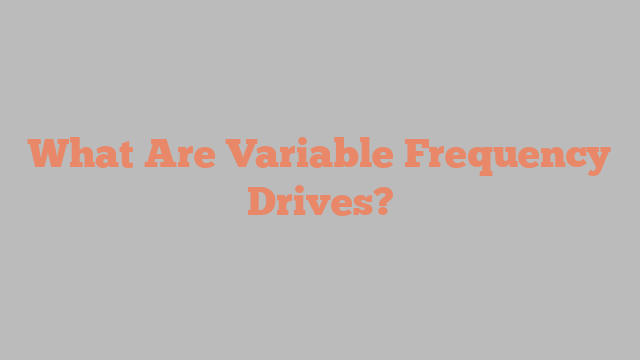Variable Frequency Drives
A variable frequency drive adjusts a motor speed to closely match a load demand for HVAC, water/wastewater treatment and machine OEM applications. They are available in many types and ratings from less than 1 horsepower to thousands of horsepower.
variable frequency drives are often a key component in energy efficiency solutions for industrial equipment. They offer a variety of benefits including reduced power consumption, improved motor performance and protection of equipment. While they can add up to a significant investment the initial cost can be offset by savings throughout extended use.

The main components of a VFD are the power and control sections. The power part of the VFD converts AC line voltage to DC voltage that is supplied to the armature windings of the drive’s connected motor. The control part of the VFD monitors and controls the voltage, current and speed of the motor using feedback data from the speed sensor. The VFD’s internal microprocessor is programmed to react within milliseconds to any input signals or fault conditions detected by the microprocessor.
What Are Variable Frequency Drives?
A VFD requires two things to operate – a run command and a speed reference. The run command tells the VFD when to start or stop the motor, while the speed reference provides the information about the desired system speed. Without these inputs the VFD sits idle. A common problem is a mismatched setup of the run command and speed reference that causes a drive to not work as expected.
An important feature of a VFD is its ability to automatically restart after a fault or an emergency stop has been cleared. This capability saves time and labor during restarts by eliminating the need to manually reset the controls after a failure.
Another function of a VFD is its ability to adjust the start and stop currents to reduce inrush power. This reduces the stress on the drives and motors during starting and stops resulting in increased reliability and longer lifespan. VFDs are also natural soft starters that can be configured to start and stop the motor at slow speeds to reduce inrush current, then accelerate and decelerate gradually.
VFDs are used in all kinds of industrial applications to control everything from fans and pumps, to electric cranes and specialized machinery. Some of the most popular include HVAC, chemical, water/wastewater, and manufacturing.
There are three types of VFDs classified based on the method of power conversion. Volts-per-hertz (V/f) is the most basic topology. It produces six current “pulses” as each diode in the drive opens and closes to regulate output to a specific frequency. This topology is easy to set up and use but does not provide the same efficiency as closed loop vector control. CSI and VSI are more sophisticated VFDs that utilize an additional circuit to monitor and control current. They can provide higher efficiency and more precise motor control, but can be more expensive than the simpler V/f topology. Ultimately, the type of VFD you select should be determined by your application needs and budget.
